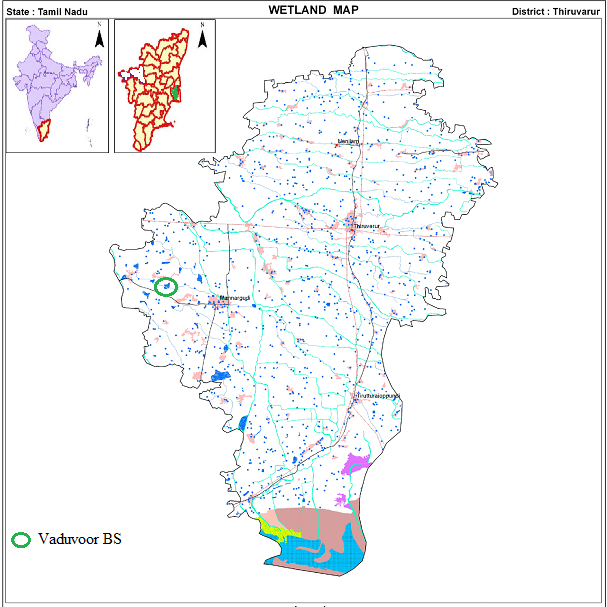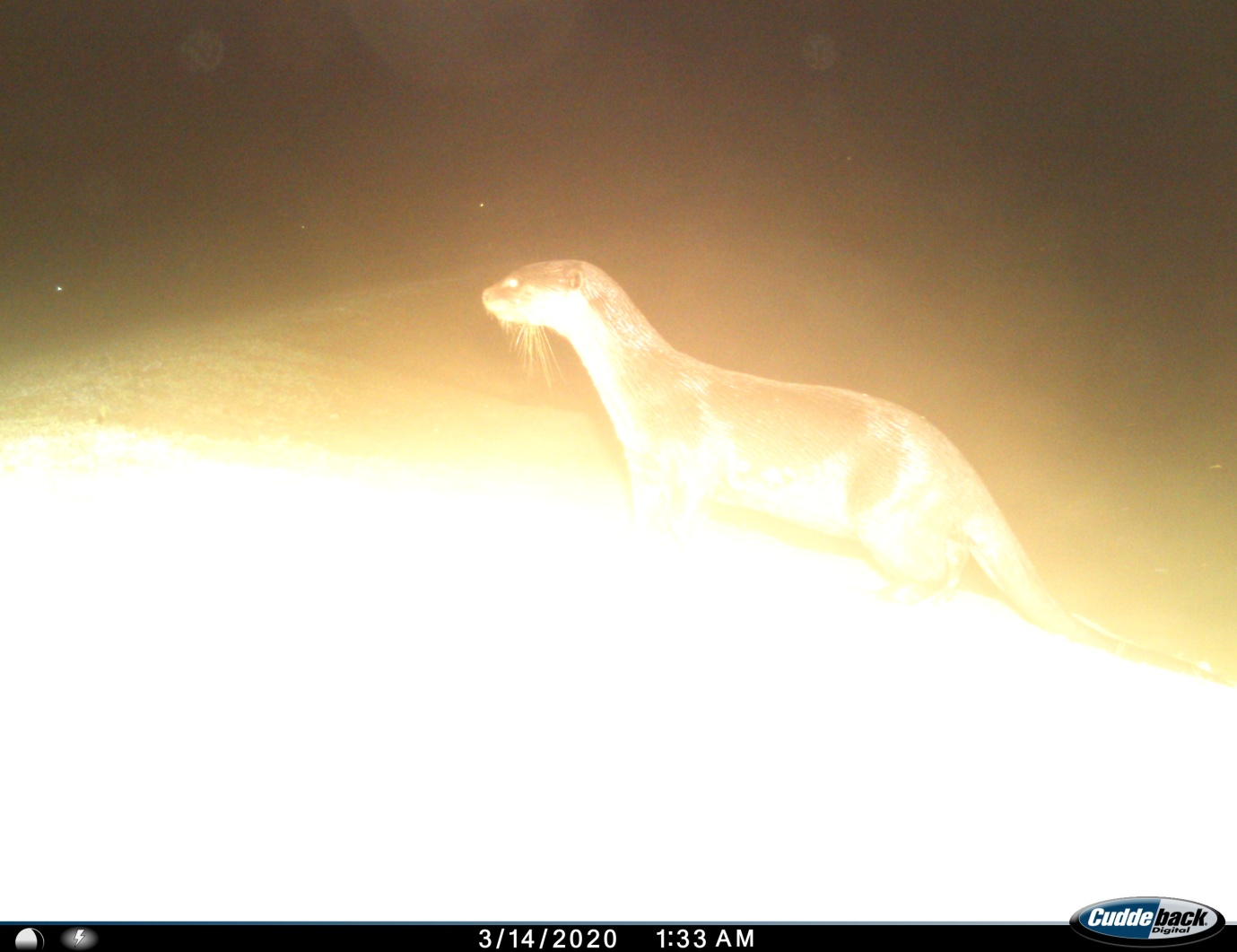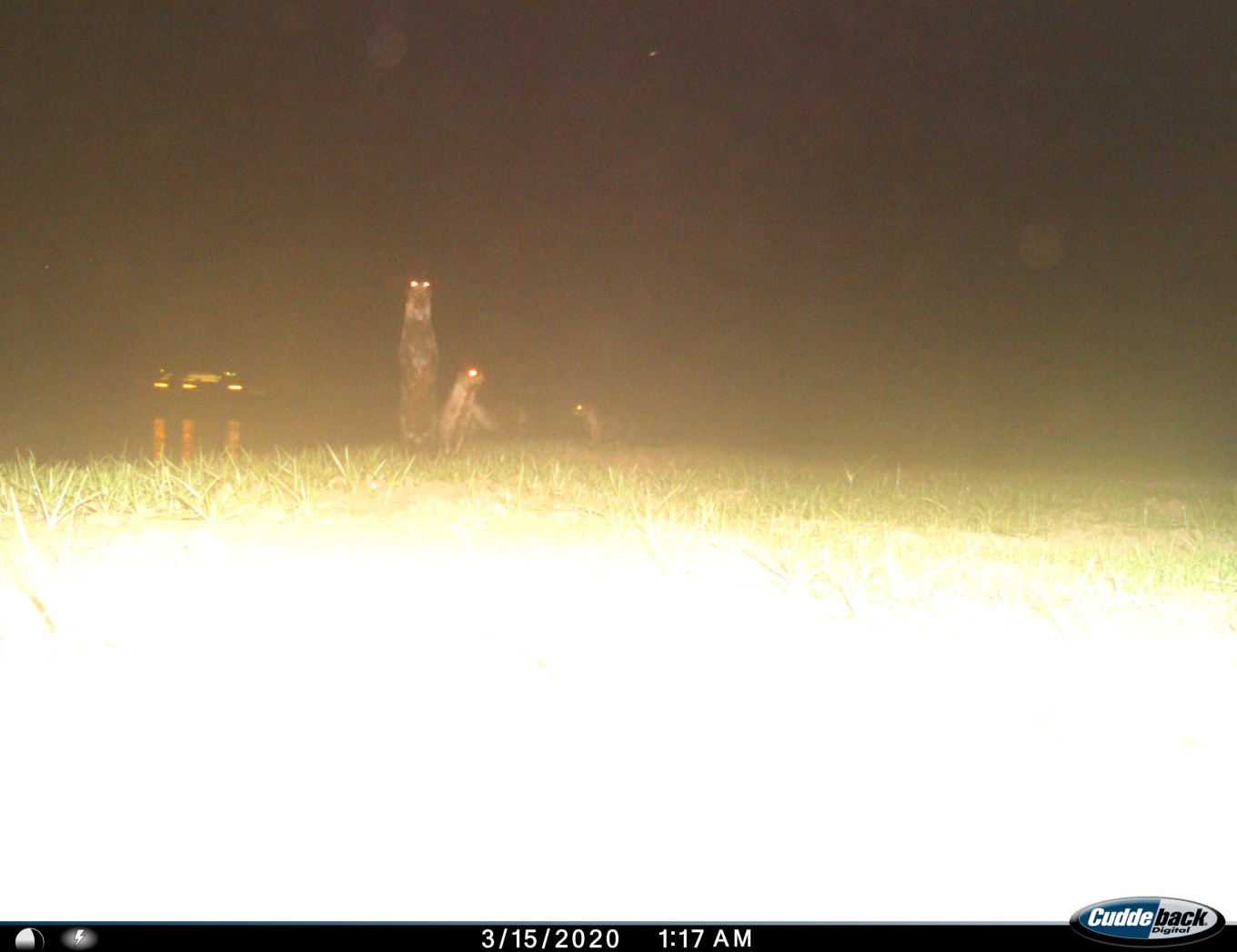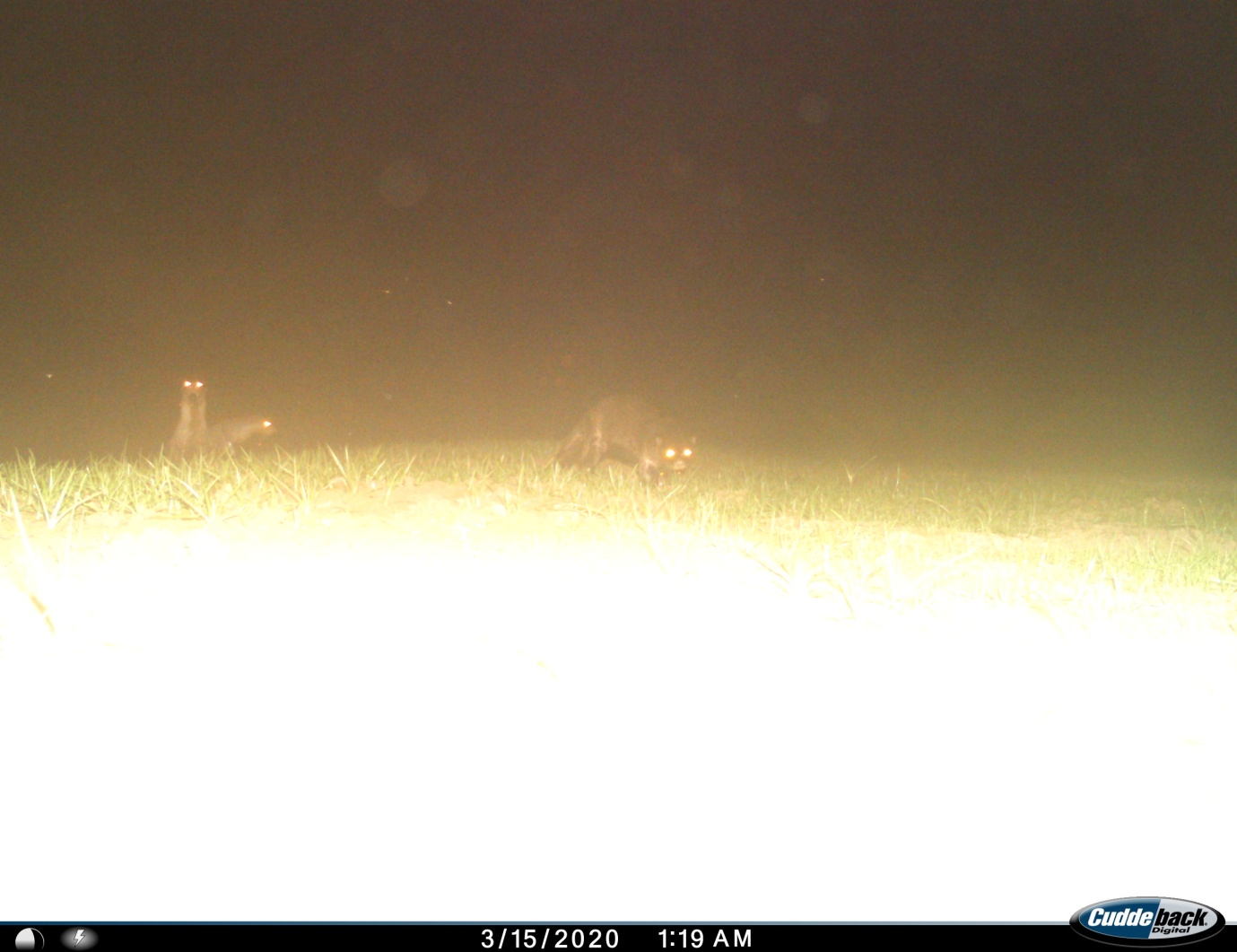IUCN/SSC Otter Specialist Group Bulletin

©IUCN/SCC Otter Specialist Group
Volume 38 Issue 2 (March 2021)
Citation: Arivoli, K. and Narasimmarajan, K. (2021). First Record of an Elusive Predator: The Smooth-Coated Otter (Lutrogale perspicillata) from Vaduvoor Bird Sanctuary, Thiruvarur District, Tamil Nadu, Southern India. IUCN Otter Spec. Group Bull. 38 (2): 79 - 84
First Record of an Elusive Predator: The Smooth-Coated Otter (Lutrogale perspicillata) from Vaduvoor Bird Sanctuary, Thiruvarur District, Tamil Nadu, Southern India
Kanagasabai Arivoli1 and Kannadasan Narasimmarajan2*
1District Forest Officer, Tamil Nadu Forest Department, Thiruvarur District, Pin- 610 004 Tamil Nadu, India.
2Department of Zoology, Madras Christian College, East Tambaram, Chennai, Pin- 600 059 Tamil Nadu, India
* Corresponding Author: E-mail wildlife9protect@gmail.com
(Received 7th August 2020, accepted 30thAugust 2020)
Abstract: Vaduvoor Bird Sanctuary is one of the oldest bird sanctuaries in the state of Tamil Nadu, spanning over the area of about 128.10 ha. During March and June 2020 camera trap survey was carried-out in the sanctuary to examine the nocturnal animals and their movements. We deployed eight trap cameras randomly within the bird sanctuary. On 14th and 15th March 2020 about 1.30 AM a family of Smooth-coated otter was captured comprising of six adult individuals and no cubs were seen. Till date no otter has been reported from the Vaduvoor Bird Sanctuary. This report presents the first ever information on the new distribution range of the Smooth-coated otters from this region, but extensive surveys are necessary to generate reliable abundance estimates and distribution patterns for otters in this region and neighboring water bodies.
Keywords: Smooth-coated otter; Vaduvoor Bird Sanctuary; Camera trap; Conservation
INTRODUCTION
Three species of otters are found in India, namely the Lutrogale perspicillata (Smooth-coated otter), Lutra lutra (Eurasian otter) and Aonyx cinerea (Oriental small-clawed otter) (Foster-Turley and Santiapillai, 1990; Hussain, 2008). Throughout India the existing populations of the three species of otters and their habitat have not been surveyed systematically and hence not much information is available on their status (Hussain, 2008). All three species of otters have been reported from the Southern Indian part of the Western Ghats (Shenoy, 2003) but no records exist from the coastal districts of Tamil Nadu.
The Smooth-coated otter (Lutrogale perspicillata) is listed as ‘Vulnerable’ under IUCN Redlist (de Silva et al, 2019). The animal lives in water bodies such as streams, rivers, lakes and dams (Kruuk, 1987), and are most vulnerable to local extinctions, since the most important threat to the survival of otter populations are the degradation of clean aquatic ecosystems (Foster-Turley, 1992). Smooth-coated otters are thought to be extinct in countries like Laos and India has a steadily declining population according to IUCN status reports (Shenoy, 2003). Other major threats to otters in India include illegal trade (Meena, 2002), reduced prey-availability persecution by fishermen and water pollution (Mason and MacDonald, 1986). At high trophic, levels otters are victim to the accumulation of contaminants in the food chains (Foster-Turley, 1992). Hence this species requires immediate conservation attention. No previous studies were conducted on otter conservation in Vaduvoor Bird Sanctuary and this is the first ever otter report from this region.
STUDY AREA
Vaduvoor Bird Sanctuary (10°42'9.39"N latitude and 79°19'4.94"E longitude) is located in Vaduvoor Agraharam Panchayat of Mannargudi Taluk of Tiruvarur district, Tamil Nadu (Fig. 1). The sanctuary is basically an irrigation tank that receives water from Cauvery basin and North East monsoon from August to December and it remains dry from April to June (Subramanya 2005). The tank is also called as Sri Kodandaramaswami Eri. The Sanctuary bounded by Kondaiyur village in North, Vaduvoor thenpathi village in South, Vaduvoor agraharam village in East and Neivasal village in West. The Kannanar and Vaduvoor canals are the main source of water to the wetland in addition to northeast monsoon. The area receives more than 384 mm rainfall annually and climate varies from 24 °C to 38 °C (Wetland Management Report, 2013).
 0
0
The sanctuary covers an area of 128.10 ha and was created in 1999. The sanctuary attracts more than 80 species of wetland birds like Oriental white ibis (Thresiornis melanocephalus), Painted stork (Mycteria leucocephala), Spot-billed pelican (Pelecanus philiensis), Northenpintail (Anas acuta), cormorants, teals and herons among others (Subramanya 2005). The sanctuary has been identified as one of the Important Bird Areas (IBA) of India by Indian Bird Conservation Network. The sanctuary is rich in aquatic flora, with submerged, floating and emergent vegetation such as Pink morning glory (Ipomia carnea) and common water hyacinth (Pontederia crassipes). The vegetation of the sanctuary is mainly composed of Prosopis juliflora, Azadirachta indica, Tamarindus indica, including planted Acacia nilotica by the forest department under the Sanctuary Management Programme (Subramanya 2005). The area surrounding the Vaduvoor Bird Sanctuary is densely populated with the human population density being 437.4 person/km2. A large population depends on the sanctuary for their livelihood thus making biodiversity conservation a highly difficult task.
METHODS
We surveyed the lake part of the sanctuary randomly using automatically triggered trap cameras (Cuddeback20MP X-Change Color Day and Night Model 1279 Game Hunting Camera). We deployed 8 trap cameras in random locations within the bird sanctuary during March and June 2020. The survey mainly focuses to study the nocturnal animal movements.
RESULTS
On 14th and 15th March 2020 an otter family was captured during the camera trap survey between 1.17 AM and 1.30 AM and the family consisted of six individuals (Figure 2, 3 and 4). This report presents the first ever otter information on the distribution range in the region. Further survey is ongoing to enumerate the movement pattern and resource use pattern of otters. Otters could possibly come from the Kannanar River. This river has many check dams which hold the water during the summer season. Two third of the tank has water up to the depth of 6 feet to 15 feet remaining area of North and Western parts has densely vegetated by Acacia nilotica and Ipomia carnea. Apparently, nearby fish farms are the vital source of food for them during the dry seasons but, no conflict has been recorded between the otters and the farm owners. Further studies will help the concern department and other stakeholders to protect the vulnerable otters in this region.



DISCUSSION
Historically Tamil Nadu is water dearth state in India. So, safeguarding existing wetland ecosystems are fundamental for species and people. Wetlands are open ecosystems vulnerable to degradation from terrestrial land uses. The potential of a wetland top predator such as the Smooth-coated otter (Lutrogale perspicillata) as a ‘proxy’ for conservation of wetland habitats has been least studied in India. Being aquatic carnivore, the intactness of land water continuum is critical for survival of otters. Increasing trends of global warming and developmental activities are impacting the wetland habitat thereby losing their associated species in many parts of the country. So, preserving the wetland ecosystems using otters as flagship species is an advisable strategy.
Acknowledgements: We would like to thank the Tamil Nadu Forests Department for their immense encouragements. We would like to thank Mr. Suresh, Forest Guard for his constant help during the field work and two anonymous referees and their constructive comments to improve the quality of the manuscript.
REFERENCES
de Silva, P., Khan, W.A., Kanchanasaka, B., Reza Lubis, I., Feeroz, M.M. & Al-Sheikhly, O.F. (2015). Lutrogale perspicillata. The IUCN Red List of Threatened Species 2015: e.T12427A21934884. https://dx.doi.org/10.2305/IUCN.UK.2015-2.RLTS.T12427A21934884.en. Downloaded on 31 March 2021.
Foster-Turley, P., Santiapillai, C. (1990). Action plan for Asian otters., pp. 52-63. In: Foster-Turley, P., Macdonald S.M., Mason C.F.(Eds.). In: Otters: An Action Plan for their Conservation. IUCN/SSC Otter Specialist Group.
Foster-Turley, P., (1992). Conservation ecology of sympatric Asian otters Aonyx cinerea and Lutraperspicillata. Ph. D. Thesis. University of Florida. 172pp.
Hussain, S.A. (2008). Otter conservation in India. Envis Bulletin - Wildlife and Protected Areas. 2: 92-97.
Kruuk, H., Conroy, J.W.H. (1987). Surveying otters Lutra lutra populations: a discussion of problems with spraints. BioI. Conserv. 41: 179-183.
Mason, C.F., Macdonald, S.M. (1986). Otters - Ecology and Conservation. Cambridge University Press, Cambridge, London. 236 pp.
Meena, V. (2002). Otter poaching in Palani Hills. Zoos Print Journal. 17(2): 696-698.
Subramanya, S. (2005). Heronries of Tamil Nadu. Indian Birds, 6: 126-140
Shenoy, K. (2003). ‘Against the current’: Otters in the River Cauvery, Karnatka, Wildlife Trust of India, New Delhi. 31pp.
Wetland Action Plan (2013). Tamil Nadu Forest Department drafting report. pp. 1-98.
Résumé: Premier Enregistrement d’un Prédateur Discret, la Loutre à Pelage Lisse (Lutrogale Perspicillata) dans la Réserve Naturelle Ornithologique de Vaduvoor, District de Tihruvarur, Tamil Nadu, au Sud de l’Inde
La réserve naturelle ornithologique de Vaduvoor est l’une des plus anciennes réserves ornithologiques de l’État du Tamil Nadu, s’étendant sur une superficie d’environ 128,10 ha. En mars et juin 2020, une enquête a été réalisée dans la réserve naturelle à l’aide de pièges photographiques pour examiner les animaux nocturnes et leurs mouvements. Nous y avons installé huit pièges photos de manière aléatoire. Les 14 et 15 mars 2020, vers 1h30 du matin, une famille de loutres à pelage lisse a été observée dont six individus adultes et aucun loutron. Jusqu’à ce jour, aucune loutre n’avait été signalée dans la réserve naturelle ornithologique de Vaduvoor. Ce rapport présente les toutes premières informations sur la nouvelle aire de répartition de la loutre à pelage lisse de cette région, mais des relevés approfondis sont nécessaires afin d’avoir des estimations fiables de l’abondance et des modèles de distribution des loutres dans cette région et les plans d’eau voisins.
Revenez au dessus
Resumen: Primer Registro de un Predador Elusivo: La Nutria Lisa (Lutrogale Perspicillata) en el Santuario de Aves Vaduvoor, Distrito de Thiruvarur, Tamil Nadu, India del Sur
El Santuario de Aves Vaduvoor es uno de los más antiguos del estado de Tamil Nadu, ocupando una superficie de 128.10 ha. Durante Marzo y Junio de 2020 llevamos a cabo un relevamiento con cámaras-trampa en el santuraio para examinar los animales nocturnos y sus movimientos. Desplegamos ocho cámaras-trampa al azar en el santuario. El 14 y 15 de Marzo de 2020, alrededor de la 1.30 AM, se capturó (fotográficamente) una familia de nutria lisa, compuesta de seis individuos adultos; no se vieron crías. Hasta la fecha, no se habían reportado nutrias lisas del Santuario de Aves Vaduvoor. Este informe presenta la primera información existente sobre la distribución de nutria lisa en esta región, pero se necesitan relevamientos extensivos para generar estimaciones de abundancia y patrones de distribución confiables, para las nutrias de esta región y cuerpos de agua vecinos.
Vuelva a la tapa

